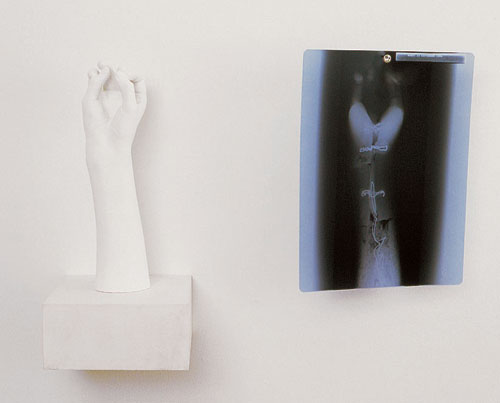La Main à 2 pouces
Trois séquences d’environ cinq minutes. La première, Base 12, défend l’idée que dans le passé lointain les hommes avaient effectivement six doigts et deux pouces. On s’appuie sur des arguments de paléontologie et sur l’examen du système duodécimal. La deuxième, Corpus Callosum, part de l’hypothèse que l’évolution va conduire l’humanité à la main à six doigts et deux pouces, plus commode pour la pratique de la peinture. Le personnage envisage les modifications que cette évolution devrait faire subir au cerveau. La troisième, Chercheur cherchant, met en scène un chercheur au travail, qui répond avec beaucoup de réticence à un interviewer imaginaire. Il remet en cause la possibilité de vulgariser ses recherches sur la main à six doigts et deux pouces, en dénonçant de manière quelque peu condescendante le souci du grand public pour les applications pratiques de la recherche.
Un tournage dans la galerie d’Emmanuel Perrotin avec des étudiants de la Femis. Ces étudiants, habitués à des tournages cinéma un peu lourds, ne se rendaient pas compte qu’il était inutile de hurler les « Moteur! », « Ça tourne! » ou « Action! », dans le cadre de mon travail. C’était assez rigolo. Un peu comme l’importation inattendue d’un signe culturel donné dans une culture qui lui serait étrangère. La fabrication des mains à deux pouces en plâtre m’avait demandé une bonne semaine dans l’atelier d’Erhard Stiefel, très enrichissante en raison du plaisir éprouvé à manipuler la matière. Des spectateurs peu avertis m’ont demandé s’il était vrai que l’humanité évoluait vers la main à deux pouces. Ça fait toujours plaisir.
The two-thumbed hand
Three sequences of approximately five minutes each. The first one, Base 12, argues that in the distant past, man had indeed six fingers and two thumbs. This is based on paleontological elements and analysis of the duodecimal system. The second sequence, Corpus Callosum, starts with the hypothesis that the evolutionary process will lead mankind to a hand with six fingers and two thumbs, more appropriate to the art of painting. The speaker reviews the changes that such an evolution would require from the brain. The third sequence, Searching Researcher, shows a scientist at work, answering with much reluctance an imaginary
interviewer. He questions the possibility of popularizing his work on the hand with six fingers and two thumbs and criticizes, with much condescension, the general public’s concern for practical implementations of his research.
It was all shot in Emmanuel Perrotin’s gallery with the help of students from the Femis, a film-school. They were used to more serious shootings and didn’t realize it was useless to roar “Quiet everybody!” and “Action!”. It was very amusing. It felt like the unexpected importation of a cultural sign into a totally strange culture. It took me more than a week to make the two-
thumbed hands in plaster in Erhard Stiefel’s studio. I got a lot out of that experience and the pleasure of handling the plaster. Uninformed people have asked me whether it was true that mankind was moving towards the two-thumbed hand. That’s always nice to hear.
|
 |
La Main à 2 pouces
Base 12 1993
Plâtre, écran vidéo, bois, 147 x 60 x 33 cm
Collection privée
Voir la vidéo (9,3Mo)
|
 |
La Main à 2 pouces
Chercheur cherchant 1993
Vidéo, plâtre, 40 x 20 x 20 cm
Collection privée
|
 |
La Main à 2 pouces
Radiographie 1993
Plâtre, radiographie, métal, 50 x 70 x 23 cm
Collection FNAC
Photographies Marc Domage
Voir les dessins |
|
|
|